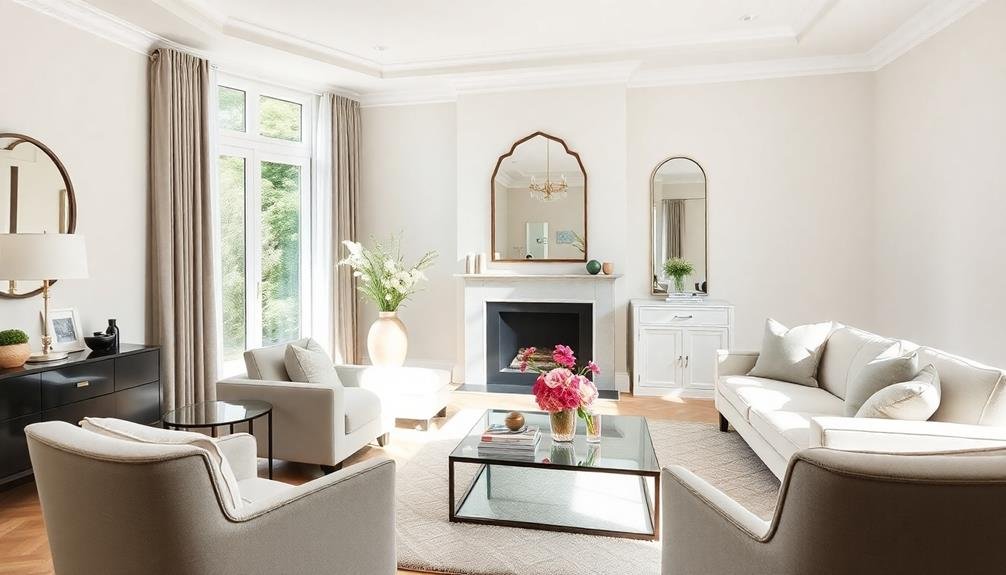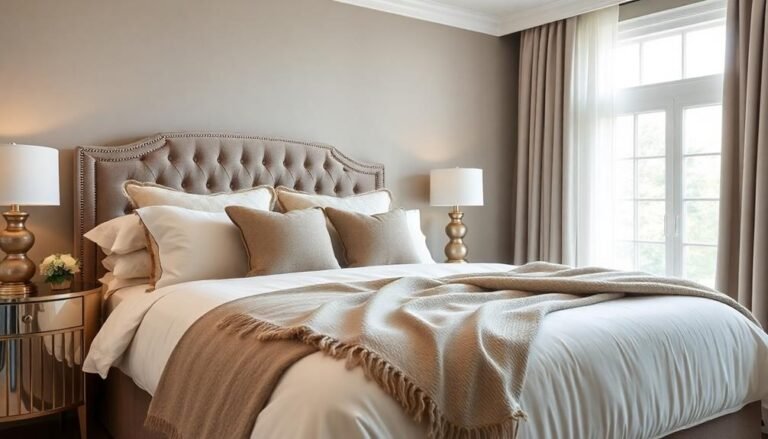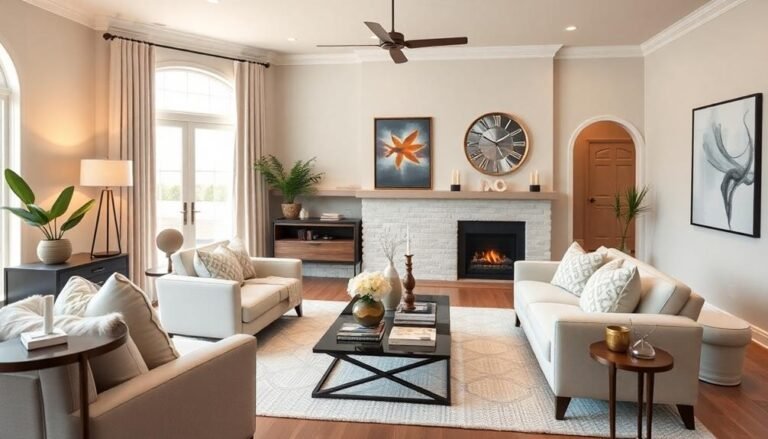Staging your home with style can greatly speed up the sale process. Start by decluttering and depersonalizing your space; this helps potential buyers envision their future there. Opt for a neutral color palette—soft beiges or grays create an inviting and sophisticated atmosphere. Highlight key features, such as fireplaces or large windows, with strategic lighting. Arrange your furniture for flow and accessibility, ensuring each room feels open. Incorporate inviting textiles like plush pillows and cozy throws, and add greenery for a fresh touch. A warm entrance sets a positive tone for visitors. With these tips, your home will shine for buyers.
Declutter and Depersonalize
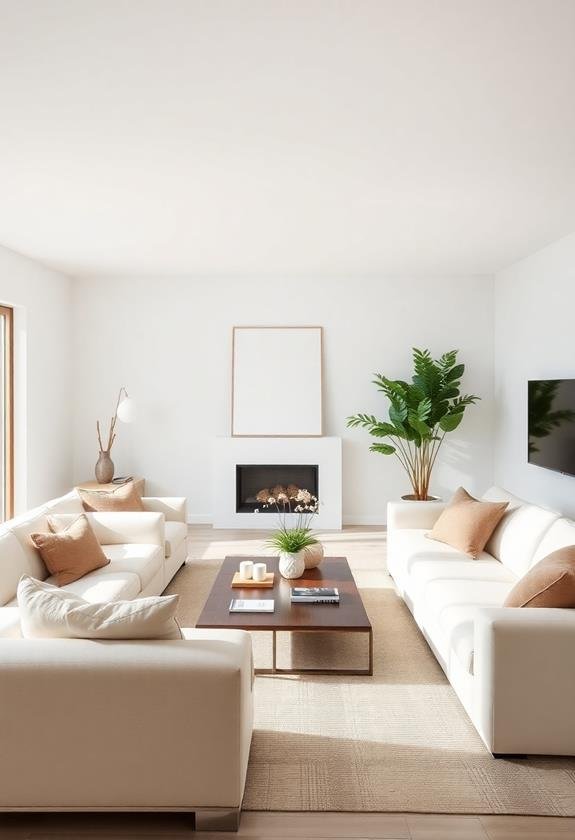
When it comes to selling your home, decluttering and depersonalizing are essential steps. You want potential buyers to envision themselves in your space, and a clutter-free environment makes that easier. Start by sorting through your belongings; consider donating items you no longer use or need. This not only reduces clutter but can also make you feel lighter emotionally. Incorporating budget-friendly decor options can also enhance the visual appeal of your home without breaking the bank. Next, focus on personal items like family photos and memorabilia. While these items may hold sentimental value for you, they can distract potential buyers from imagining their own lives in your home. Instead, opt for neutral decor that appeals to a broader audience.
Don't forget about your closets and storage spaces. Buyers will likely peek inside, so organizing these areas is vital. Aim for a minimalist look; this not only maximizes space but also demonstrates that your home has ample storage.
Lastly, take a critical look at each room. Removing excess furniture can create an open, airy feel that invites buyers to linger. By decluttering and depersonalizing, you create a welcoming atmosphere, allowing buyers to picture themselves living in your home and increasing the chances of a quick sale.
Choose a Neutral Color Palette
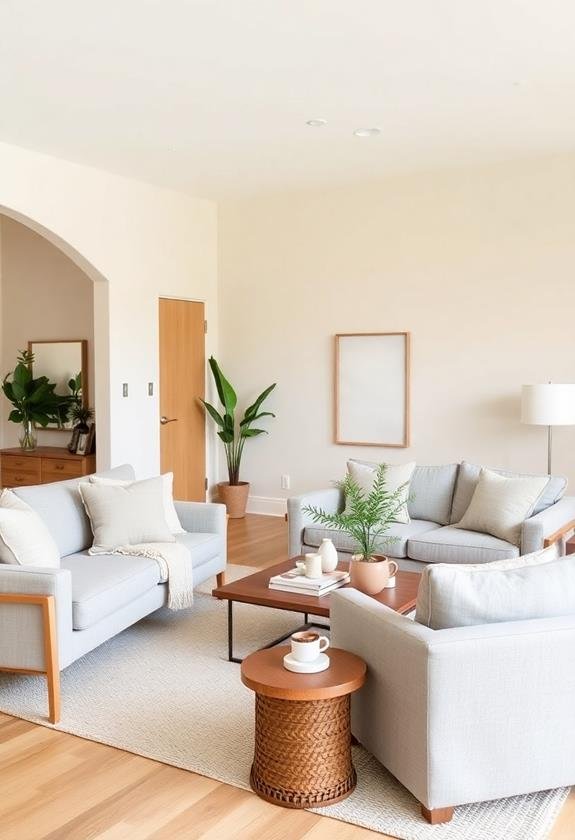
Choosing a neutral color palette can greatly boost your home's appeal to potential buyers. When you opt for soft, muted tones like beige, gray, or off-white, you create a blank canvas that allows prospective buyers to envision their own style in the space. These colors not only make rooms feel larger and brighter, but they also exude a sense of calm and sophistication, aligning with current home decor trends for 2024 that emphasize serene environments.
For instance, painting your living room in a light gray can bring out the architectural features of the space, while a warm beige in the kitchen can create an inviting atmosphere. This neutrality invites a wider range of tastes, ensuring that your home doesn't alienate anyone with bold or unconventional choices.
Additionally, don't forget the importance of consistency. Aim to use a similar color palette throughout your home, which can provide a cohesive feel. This strategy helps buyers understand how the spaces connect, enhancing their overall experience during a showing. Remember, the goal is to create an environment that feels fresh, clean, and ready for new memories. By choosing a neutral color palette, you're setting the stage for a successful sale.
Highlight Key Features
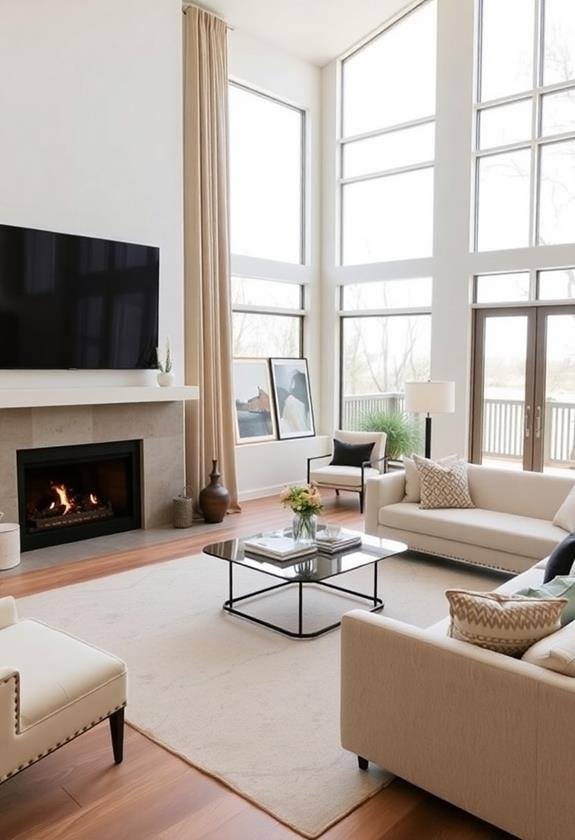
Highlighting key features of your home can make a significant impact during showings. Start by identifying the unique elements that set your home apart, like a stunning fireplace, built-in shelving, or large windows that let in natural light. These characteristics not only enhance your space but also create a lasting impression on potential buyers. Incorporating quality decor elements such as stylish accessories and art can further elevate the aesthetic appeal of these features.
To draw attention to these features, consider using lighting strategically. Soft lamps or accent lights can illuminate your fireplace or artwork, making them focal points in the room. You might also want to declutter surrounding areas, allowing buyers to appreciate the feature without distractions.
Another effective method is to use decor that complements these key features. For instance, place a stylish vase or a few decorative items on a mantel to frame the fireplace beautifully. In the kitchen, fresh herbs in attractive pots can highlight a spacious countertop.
Lastly, don't forget about curb appeal. A well-maintained garden, clean entryway, and inviting front door can showcase your home's exterior features and set the tone for what's inside. By emphasizing these standout traits, you'll create a memorable experience for potential buyers.
Optimize Furniture Placement
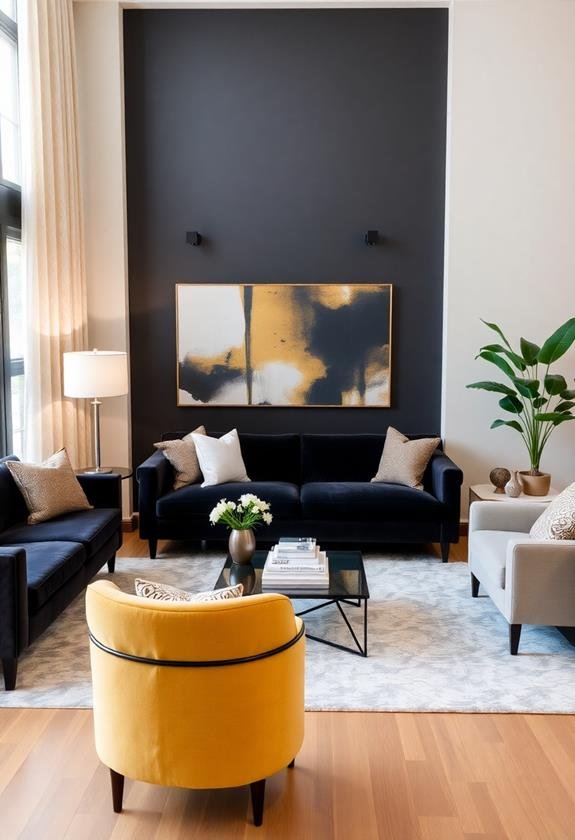
To make the most of your home's appeal, optimizing furniture placement can greatly enhance its flow and functionality. Start by creating a natural flow throughout your space; guarantee there's enough room for movement. For instance, in a living room, arrange seating in a way that encourages conversation, such as facing each other instead of pushing everything against the walls. This setup not only maximizes space but also creates an inviting atmosphere.
Next, consider the purpose of each room. In a dining area, place the table centrally, allowing chairs to be easily accessible without blocking pathways. You want prospective buyers to envision themselves living comfortably in your space.
Don't forget about focal points, like a fireplace or a large window. Position furniture to draw attention to these features, enhancing the overall appeal. Additionally, try to avoid overcrowding; too much furniture can make a room feel cramped. Instead, select key pieces that complement the room's dimensions and style.
Add Inviting Textiles

When you incorporate inviting textiles into your home, you instantly create a warm and welcoming atmosphere that can attract potential buyers. Start with soft, plush throw pillows on your sofas and chairs. These not only add comfort but can also introduce color and texture, making your living spaces feel more inviting. Choose fabrics like cotton or linen in neutral tones, or select deeper hues that complement your existing decor.
Next, consider layering your bedding with cozy quilts or decorative throws. A well-styled bed can make a significant impact, transforming a simple bedroom into a serene retreat. Use a mix of textures, such as a knitted throw or a silky duvet, to evoke a sense of luxury.
Rugs also play an essential role in adding warmth to your floors. Opt for area rugs that define spaces and create an inviting flow throughout your home. They can soften hard surfaces and help unify your design elements.
Incorporate Greenery
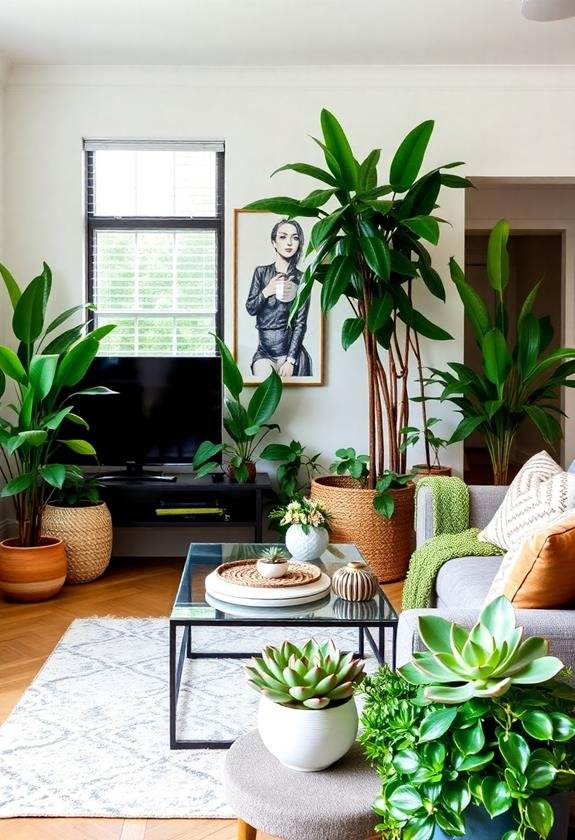
Incorporating greenery into your home can make a huge difference, especially when you're aiming for a quick sale. Plants not only add life and color to your space, but they also create a welcoming atmosphere that potential buyers find appealing. Consider placing a few strategically chosen houseplants in key areas, like the living room or kitchen. A tall, leafy plant in the corner can draw the eye upward, making the room feel larger and more inviting.
You might also want to use smaller plants on shelves or tables to create visual interest. Succulents and snake plants are low-maintenance options that thrive in various light conditions. If you're looking for a burst of color, vibrant flowering plants can brighten up any space, making it feel warm and inviting.
Don't forget about your outdoor areas, too. A well-kept garden or potted plants on a patio can enhance curb appeal and make a strong first impression. Maintaining healthy greenery shows buyers that the home has been well cared for. By incorporating these natural elements, you'll create an inviting ambiance that encourages potential buyers to envision themselves living in your home.
Use Strategic Lighting
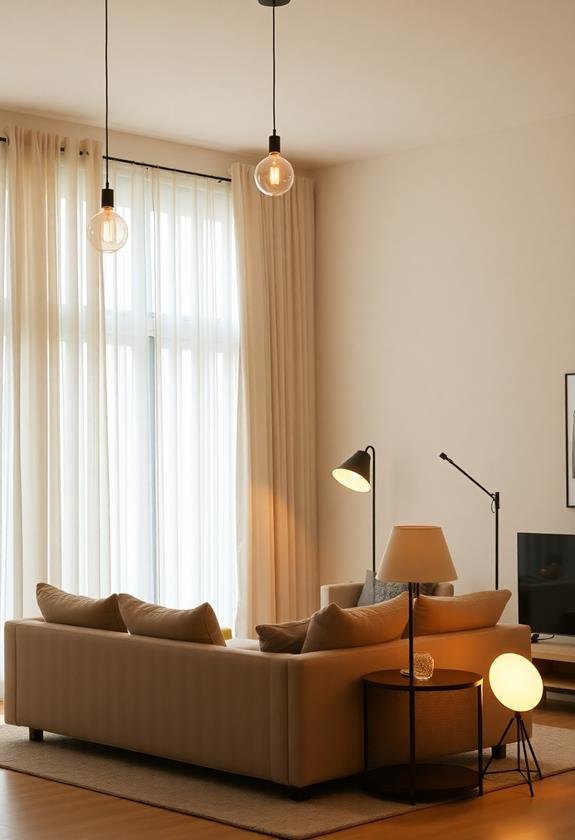
If you want to create a welcoming atmosphere that highlights your home's best features, using strategic lighting is essential. Begin by identifying key areas in your home that deserve attention, such as living rooms, kitchens, and bedrooms. Use a mix of ambient, task, and accent lighting to create depth and warmth. Ambient lighting provides overall illumination, while task lighting focuses on specific activities, like reading or cooking.
Consider installing dimmer switches to adjust the brightness according to the time of day or occasion. This flexibility allows potential buyers to envision how they'd use the space. For example, soft, warm lights in the evening can create a cozy, inviting environment.
Don't forget about natural light! Open curtains and blinds to let in as much sunlight as possible during showings. It not only enhances the space but also makes the rooms feel larger and more inviting.
Create a Welcoming Entrance
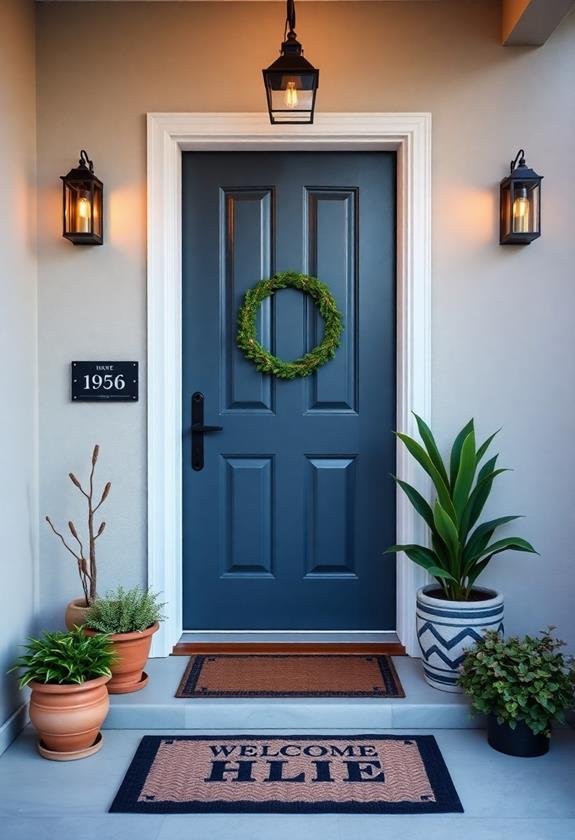
A welcoming entrance sets the tone for your entire home, making a lasting impression on potential buyers right from the start. To create this inviting space, begin with a thorough cleaning. Remove any clutter, such as shoes or gardening tools, that might distract from your home's charm.
Next, consider a fresh coat of paint on your front door; a bold color like red or navy can make your entrance pop. Add a tasteful, seasonal wreath to infuse a touch of warmth and personality.
Don't overlook the importance of lighting. Ascertain your entrance is well-lit, whether by replacing old fixtures or adding outdoor sconces. Bright, inviting lights create a sense of safety and allure.
Frequently Asked Questions
How Much Does Staging a Home Typically Cost?
Staging a home typically costs between $1,500 and $5,000, depending on various factors like location and the size of your home. Notably, homes that are staged sell 73% faster than those that aren't. This means investing in staging could yield a quicker sale and potentially a higher price. Whether you hire professionals or rent furniture yourself, the right staging can make a significant difference in how buyers perceive your property.
Can I Stage My Home While Living in It?
Yes, you can stage your home while living in it. Start by decluttering, removing personal items, and creating a neutral atmosphere—this helps potential buyers envision themselves in the space. Rearranging furniture to enhance flow and lighting can greatly impact how your home feels. Consider using minimal decor to highlight features without overwhelming the space. Remember, keeping it clean and tidy is essential; it guarantees your home looks inviting even during showings.
Should I Hire a Professional Stager or DIY?
When deciding whether to hire a professional stager or tackle it yourself, consider your budget, time, and skills. If you've got a keen eye for design and enough time, DIY can be rewarding, allowing you to showcase your unique style. However, if you're short on time or unsure of your aesthetic choices, a professional stager can bring expertise, creativity, and a fresh perspective to elevate your home's appeal effectively.
How Long Does Home Staging Usually Take?
Home staging usually takes anywhere from a few days to a couple of weeks, depending on the size of your home and the extent of the changes needed. If you're hiring a professional, they might streamline the process, but DIY staging could take longer since you'll need to gather decor, furniture, and arrange everything. Regardless, planning ahead and setting a timeline will help you stay organized and guarantee your space looks its best.
What Are the Benefits of Staging for a Quick Sale?
When you stage your home, you're making it more appealing to potential buyers. It highlights your home's best features and helps them envision their own lives there. Staged homes often sell faster and at higher prices, as they create a lasting impression. For example, a well-arranged living room can evoke feelings of warmth and comfort. Fundamentally, staging transforms your space into a desirable product, increasing your chances of a quick sale.

